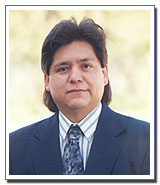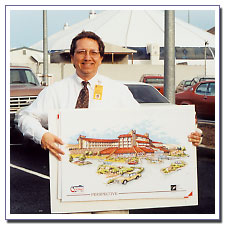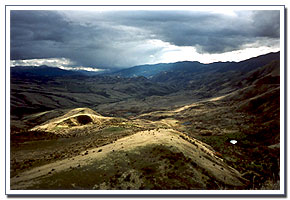
Nez Perce tell own story of Lewis and Clark's Journey
Crystl Murray
Nez Perce Wolf Recovery has friends and foes
Crystl Murray
Redtail Singers: Songs can lift a person's heart
Wyatt Buchanan
Tribal ethnographer passes on heritage to younger generation
Leah Andrews
Memorandum tries to strengthen university and tribal ties
Morgan Winsor
Nez Perce horse culture resurrected through new breed
| By Wyatt Buchanan and Jade Janes LAPWAI — Nez Perce Tribal Chairman Samuel Penney drives 66 miles one-way to work, everyday. When he winds down Highway 12 from Kamiah to the Tribal headquarters in Lapwai, he traverses the Nez Perce Reservation from one end to the other along the Clearwater River.
In 1855, the Nez Perce signed a treaty with the U.S. Government reserving 7.5 million acres of this land. But after gold was discovered on the reservation in 1860, the tribal lands were reduced to the current size. In 1887 the Dawes Act opened the reservation to homesteading that resulted in non-Indians owning parcels of fee-patented land within the reservation next to Indian trust allotments. That created a "checkerboard" pattern of land ownership on the reservation and problems over jurisdiction have resulted. Today the Nez Perce own 86,248 acres of land and individual tribal members own an additional 37,950 acres. Penney’s daily trek serves as a symbol of the tribe’s daily life: the navigation of a windy and difficult road that must be traveled — everyday. Providing economic stability to the Tribe, the area is important to him and gaming has helped. In 1995, the Nez Perce Tribe began its venture into gaming with the It’se-Ye-Ye Casino in Kamiah. That was followed a year later by the inflation of the tent-like Clearwater River Casino building east of Lewiston. Since its construction, the tribe has talked of a permanent building for the Clearwater Casino. The tribe now has preliminary drawings of a $30 million casino resort that triples the size of the current building to accommodate a hotel, convention center, and other amenities, according to Robert Lee, former manager of the casino.
The two casinos employ about 250 people, both Indian and non-Indian, and net between $2 million and $3 million a year. This money pays for a myriad of things, but mostly goes to the tribal government, tribal economic development and tribal member services. These services include senior citizen and language programs. The remainder is voluntarily given to support local governments through police and fire services, charitable organizations like the Boys and Girls Club, and local schools. Despite a political conflict over the legality of the electronic gaming machines, the Tribe is moving forward with plans for expansion. |
Over the past six years, the tribe has spent about $4.5 million on land, infrastructure, judicial services and law enforcement. However, Penney believes more needs to be done and the possibility of contracting opportunities with the Department of Defense could add to revenues. Relicensing of dams could also provide mitigation funds for wildlife improvements. The issue of checkerboard land status has created a stir among non-Indian neighbors but Penney believes through education and communication, issues can be resolved. The jurisdictional issues prompted the formation of a group that calls itself the North Idaho Jurisdictional Alliance, a group of 23 local governmental entities on the reservation founded in 1997 that challenges the tribe’s sovereignty over reservation lands it does not own. The alliance, composed of school districts, highway districts and city and county governments, spars with the tribe over things like water rights and tax revenues. Before the current conflict escalates beyond legal challenges, the John F. Kennedy School of Government at Harvard University has stepped between the tribe and the alliance to help mediate their differences. Professors from the school have surveyed tribal members and non-Indians living on the reservation and the parties met face-to-face in January. Within the tribe, there is a push to preserve cultural resources. Vera Sonneck, cultural resource program director, said the Nez Perce Tribal Cultural Resource Program works to protect, preserve and perpetuate the culture and language of the tribe. The program includes a Nez Perce language program, an arts council, archaeologists that help protect sacred sites and a "Circle of Elders," who help oversee the language program meeting once a month. Sonneck said the program provides recommendations to tribal programs for effective cultural preservation. It also monitors areas where there are federal and state projects within the reservation and protects cultural properties on and off tribal lands.
Federal funds aid these programs, but in the long run, the continuation of cultural programs will depend on the economic stability of the tribe. According to a survey conducted by the University of Idaho Center for Business Development and Research, the tribe has had a significant economic impact in the community. Tribal enterprises increased nearly 300 percent from 1995 to 2000. Most of the earnings — $10.5 million — came from the Clearwater River Casino. Employment increased 220 percent, dramatically decreasing staggering winter unemployment figures of close to 70% that existed before the advent of tribal gaming. Despite the progress the tribe has made, Penney sees more to be done. "It’s just about a nonstop job," he said. "There’s something that you need to be doing all the time." |
|||||||||
|
||||||||||


 © photo:
ludmilla p. saskova
© photo:
ludmilla p. saskova